Navigation
- Browse Navigation
- In short
- About aperture
- Main Specifications
- Assembly
- Focusing
- Diaphragm
- Image quality
- Sample Photos
- Unlike the previous version of Canon 50 1.8 II
- My experience
- Alternatives
- Prices / where to find
- Results
- User Comments
- Add your review, comment or question on the lens
In the review, I will refer to Canon EF Lens 50mm 1: 1.8 STM for short - Canon 50 / 1.8 STM. In different sources, catalogs or stores, the name of the lens may be indicated a little differently.
In short
Canon EF Lens 50mm 1: 1.8 STM is a classic XNUMXmm lens.
Between photographers and amateur photographers'fifty dollars' or 'a half'it is customary to call lenses with a focal length of 50 mm, drawing an analogy with a coin of 50 kopecks, which is also called'half a ruble'or' a half '.
Canon 50 / 1.8 STM is a balanced lens, its price / quality indicators are at a high level. This is one of the best-selling Canon EOS SLR cameras (at the time of writing, 2018). Canon 50 / 1.8 STM can be used in a very wide range of photo tasks. It is used by both professionals and amateurs.
Canon 50 / 1.8 STM primarily attracts at the cost aperture, image quality and focus stepper motor. Canon 50 / 1.8 STM can be safely bought for any Canon EOS camera, be it an entry-level camera such as Canon EOS 1300D, or TOP Canon EOS-1D.
About aperture
Max open diaphragm F / 1.8, which is used by Canon 50 / 1.8 STM and any other lenses with F / 1.8, more than three degrees wider aperture F / 5.6, which is used in the 'dark' (with small aperture) whale lenses at the extreme position of their focal length. This means that the Canon 50 / 1.8 STM is approximately 10 times brighter (transmits more light) than, for example, a universal whale lens Canon EF-S 18-55 / 3.5-5.6 IS STMwhich uses a maximum relative aperture of only 50: 1 over a 5.6 mm focal length.
The calculation of the difference in the relative aperture (count the aperture) is performed elementarily: (5.6 * 5.6) / (1.8 * 1.8) = 9.679, which is rounded to the value '10'. The count is true for any lenses that use F / 5.6 on their long end. Net difference in exposureexpressed in T-stepsmost likely also close to ten.
The wide aperture of F / 1.8 allows in a number of situations to bypass the increase in ISO level, lowering excerpts or flash application. Also, with F / 1.8 you can get a very narrow depth of field and a very blurry foreground and background. Many amateur photographers buy the Canon 50 / 1.8 STM just for the sake of the vaunted blur of the background, which is also called bokeh.
Main technical specifications Canon EF Lens 50mm 1: 1.8 STM
| Review Instance Name | Near the front lens 'Canon EF Lens 50mm 1: 1.8 STM ø49mm'. Canon body 50mm 0.35m / 1.1ft-∞. Mount side Canon INC. Made In Malaysia. On Canon EF 50mm f / 1.8 STM box |
| Basic properties |
|
| Front Filter Diameter | 49 mm, plastic thread for filters |
| Focal length | 50 mm
|
| Zoom ratio | 1 X (this is a fixed focal length lens, it does not have zoom) |
| Designed by | for full-frame digital SLR cameras. Lens fit for all Canon EOS SLR cameras |
| Number of aperture blades | 7 rounded petals |
| Tags | mark of bayonet mount and hood mount, marker indicating MDF in meters and feet |
| Diaphragm | F / 1.8 to F / 22 |
| MDF | 0.35 m, maximum magnification ratio 1: 4.8 (the smaller the second number, the better for macro photography) |
| The weight | 160 g |
| Optical design | 6 elements in 5 groups. The lens does not use special optical elements in its optical design. Lenses have a special enlightenment, optimized for working with digital cameras.
The image of the circuit is clickable. The same optical scheme is used by lenses:
|
| Lens hood | Hood Canon ES-68 (analogues here) The hood can be installed in the opposite direction for transportation or storage. |
| Manufacturer country | Made In Malaysia (Made In Malaysia) |
| Period | May 13, 2015 to the present |
| Instructions | View -> |
| 3D view | View -> |
| Price | You can view and buy with free shipping here |
Canon 50 / 1.8 STM is already the third reincarnation of such a lens from Canon, therefore, a priori, the lens cannot be bad.
Assembly
Canon 50 / 1.8 STM, as for a budget lens, assembled well. It is strong enough to the touch with a metal bayonet mount.
A slight lack of confidence in the strength causes the outgoing trunk of the lens, as well as the absence of any dust and moisture protection.
The focus ring, unfortunately, is not rubberized, but still quite pleasant to the touch.
Canon 50 / 1.8 STM can use Canon ES-68 plastic bayonet hood (analogues from the Chinese here), which is installed in the grooves on the lens barrel. It is very good that the lens hood is mounted on the body, and not on the outgoing trunk of the lens. The hood can be installed in the opposite direction for convenience during transportation, in this state access to the focus ring is completely lost.
Plastic thread for filters. With the lens, I used polarizing filters without any problems. The trunk of the lens withstood the frequent and merciless rotation of the polarik rings for a long period.
Focusing
The lens uses technology to focus STM (STepper Motor) with a stepping focus motor that allows for smooth, quiet and fast focusing.
STM technology is very important when shooting video where speed, smoothness and low noise are required. The potential of STM technology can be maximized in Live View with cameras that support Hybrid CMOS focusing technology AFHybrid CMOS AF II Hybrid CMOS A.F. III и Dual Pixel CMOS AF. Cameras that can do this are listed. here.
Despite claims of quiet focus, there is noticeable noise from the focus motor, which can greatly interfere with those who will shoot video and record sound using the microphone built into the camera.
When used on a camera Canon EOS D30 (Serious? with most unpretentious focusing system among all CZK Canon), as well as Canon EOS 550D and Canon EOS 5D Mark III, the lens performed well. I had no particular problems with accuracy and tenacity of focusing - the lens rarely refocused and kept the subjects in focus quite tenaciously. Just on Canon EOS D30 in servo AI tracking mode, the lens often scoured back and forth.
On camera Canon EOS 550D I checked the presence of back and front focus at different focusing distances (infinity and MDF including). As a measure, the images were taken using the Live View mode (which actually does not suffer from back / front focus). Focusing accuracy using a cross-type center phase focusing sensor was exactly the same as Live View.
Auto focus speed average (not high, but not low). Unfortunately, the focusing time from infinity to MDF and back is approximately twice as much, than at Canon Lens EF 50mm 1: 1.8 II. In general, the Canon 50 / 1.8 STM focusing speed is enough for comfortable operation.
Canon 50 / 1.8 STM uses electronic (electromechanical) focus ring.
There is a 'AF / MF' (auto focus / manual focus) switch on the body to select the focus mode.
Canon 50 / 1.8 STM supports mode FTM (Full Time Mannual Focus) - continuous manual focus control, which allows manual focusing in 'AF' mode without switching to 'MF' mode. Unfortunately, in fact, according to the manual, manual focus in the 'AF' switch mode is available only after focusing on the subject and only with the 'ONE SHOT AF' AF method. In fact, due to the fact that manual focus adjustment can only be made when the shutter button is pressed halfway, talking about the constant possibility of manual focus correction is simply impossible. For manual focusing, it is still much easier to simply switch the lens to 'MF' focus mode than to try using FTM. Some of the features of working with FTM are described in detail in the Canon 24-105 / 4 L IS USM lens reviewwhich also possesses FTM.
During focusing, the front lens does not rotate, but with the frame of the body (trunk) drives forward. Thus, it is possible to use any filters without special problems, for example polarizing or gradient. But still I would like the focus to be internal or virtually internal type, for example, like inexpensive Chinese YONGNUO 50mm 1: 1.8 (YN50mm F1.8N).
During auto focus, the focus ring remains stationary. In manual focus mode, the focus ring rotates approximately 180 degrees. When extreme positions are reached, the focus ring does not rest, but continues to slide, without affecting the focus. Manual focus is comfortable enough.
The minimum focusing distance is only 35 centimeters, which is better than most modern similar lenses. The maximum magnification ratio for macro photography is 1: 4.8 (magnification 0.21 X).
Focus Features:
- Canon 50 / 1.8 STM does not have depth of field scale, focusing distance scale and marks for working in the infrared spectrum. But all this was still in the first such model - Canon Lens EF 50mm 1: 1.8.
- Focusing is done by moving the entire lens unit in the middle of the lens barrel. Whether there is support for floating elements is unknown.
- Canon 50 / 1.8 STM does not have a hard stop (hard infinity mechanical stop) which allows you to accurately and quickly focus the lens to infinity under any external temperature conditions. For accurate aiming at infinity, you cannot just bring the focus ring to the extreme position from the side of infinity.
- Canon 50 / 1.8 STM has little effect 'Focus breathing'(changes in viewing angle during focusing). When focusing on MDF, effective focal length increases and, as a result, the viewing angle decreases.
- Focus shift (shift-focus) was not noticed during operation and testing.
- The Canon 50 / 1.8 STM the trunk lengthens when focusing towards MDF. When metering is off on the camera exposure, or the camera is turned off, or the lens is detached from the camera, then it is impossible to remove / hide the lens trunk, since in this position the electronic focusing ring does not work. The trunk can be pushed in by hand - but this is highly discouraged.
- There is a microscopic lag of the focusing ring (reaction delay) when the ring rotates in one or the other direction. This is the normal behavior described by the instruction. Most of all, the delay manifests itself with a sudden rotation of the focus ring.
- Manual focus speed directly depends on the STM system, and not on the speed of the photographer’s hand movements.
- In manual focus mode, the STM system beeps significantly louder than in AF mode. Also, the noise has a different character, when you rotate the focus ring of the Canon 50 / 1.8 STM, the noise is similar to the hum of a transformer. I observed this behavior with some other lenses with STM technology. This behavior of the electronic ring and the STM motor can be considered a drawback, since during manual focusing of lenses with a classic mechanical focus ring you can achieve almost silent operation.
- In manual mode, the lens consumes camera energy, since the focus ring is not mechanically connected to the lens block, and an electric drive is still used to move it.
- Canon 50 / 1.8 STM focuses well in Live View, including when shooting video. The accuracy and response of the lens is very much dependent on the focusing method that the camera uses in Live View.
- Important: in manual focus mode 'MF', the electronic focusing ring works only when the metering is active (in rare and incomprehensible cases - a little longer). In the opposite state, even if the camera is turned on, rotating the focus ring will have no effect. For example, on my camera Canon EOS D30 metering stops after just 4 seconds of inactivity or inactivity, after which the electronic focus ring stops responding to rotation. At the same time, on the Canon EOS D30 it is impossible to set a different time for the metering activity, which creates an additional inconvenience during prolonged use of the Canon 50 / 1.8 STM in manual focus mode. Typically, on all Canon EOS cameras, by default, exposure metering is turned on by half-pressing the shutter button or by pressing the '*' button. With the same Canon EOS D30 (and with other cameras) and Canon 50 / 1.8 STM for comfortable work in manual focusing mode 'MF' you should often press or even keep pressing the button '*' or half-pressed the shutter button.
- Important: in auto focus mode 'AF', the electronic focusing ring also works only when metering is active.
- Important: in auto focus mode 'AF', the electronic focus ring works only when the focus activation button is pressed (usually half-pressing the shutter button, sometimes another button, for example AF-ON).
- Manual focus not available while previewing depth of field
- The electronic ring does not react linearly to rotation - the faster you rotate, the stronger the effect you get. You can get used to it very quickly.
- On Canon EOS mirrorless cameras, the lens can be used with an adapter Canon mount adapter EF-EOS M
- Canon 50 / 1.8 STM can be used with extension rings for macro photography.
Diaphragm
The diaphragm device consists of seven blades. The petals are rounded, but, unfortunately, a fairly round and even hole is available only not on heavily covered diaphragms
- at F / 2-F / 5.6 the blur circles are fairly even
- on F / 5.6-F / 22 values, the circles of confusion are regular heptagons
Seven petals are much better than the five petals of previous models Canon Lens EF 50mm 1: 1.8 и Canon Lens EF 50mm 1: 1.8 II.
Image quality
From my experience with the full-frame Canon 5D Mark III.
In general, the Canon 50 / 1.8 STM is optically good and even good.
- the lens is confident and sharp enough at f / 1.8 in the center of the frame
- any claims to sharpness in the center of the frame disappear at apertures starting with F / 2.8
- in the corners and edges of the frame there is a subsidence of resolution, especially felt at open apertures. The main reason is coma
- at the edges of the frame, sharpness becomes acceptable after f / 4.0
- excellent resolution in the center of the frame on covered apertures after f / 4
- the lens suffers from perceptible vignetting; on a full-frame camera, vignetting disappears almost completely at F / 4 aperture
- vignetting amplified with focus towards MDF
- vignetting is easy to correct on RAW images
- general level vignetting is within the range typical for such lenses
- low chromatic aberration
- there is barely noticeable distortion, the overall level of distortion is at the level characteristic of such lenses
- distortion is uniform, barrel-shaped, easy to correct on RAW images
- I did not find any problems with color reproduction
- the lens creates a small amount of glare and flare when working in backlight. Despite the new SSC enlightenment, the amount of glare remained at the level of Canon Lens EF 50mm 1: 1.8 II
The 'artistic possibilities' of a lens, including bokeh, are completely dependent on the photographer's ability to frame the frame and are highly subjective.
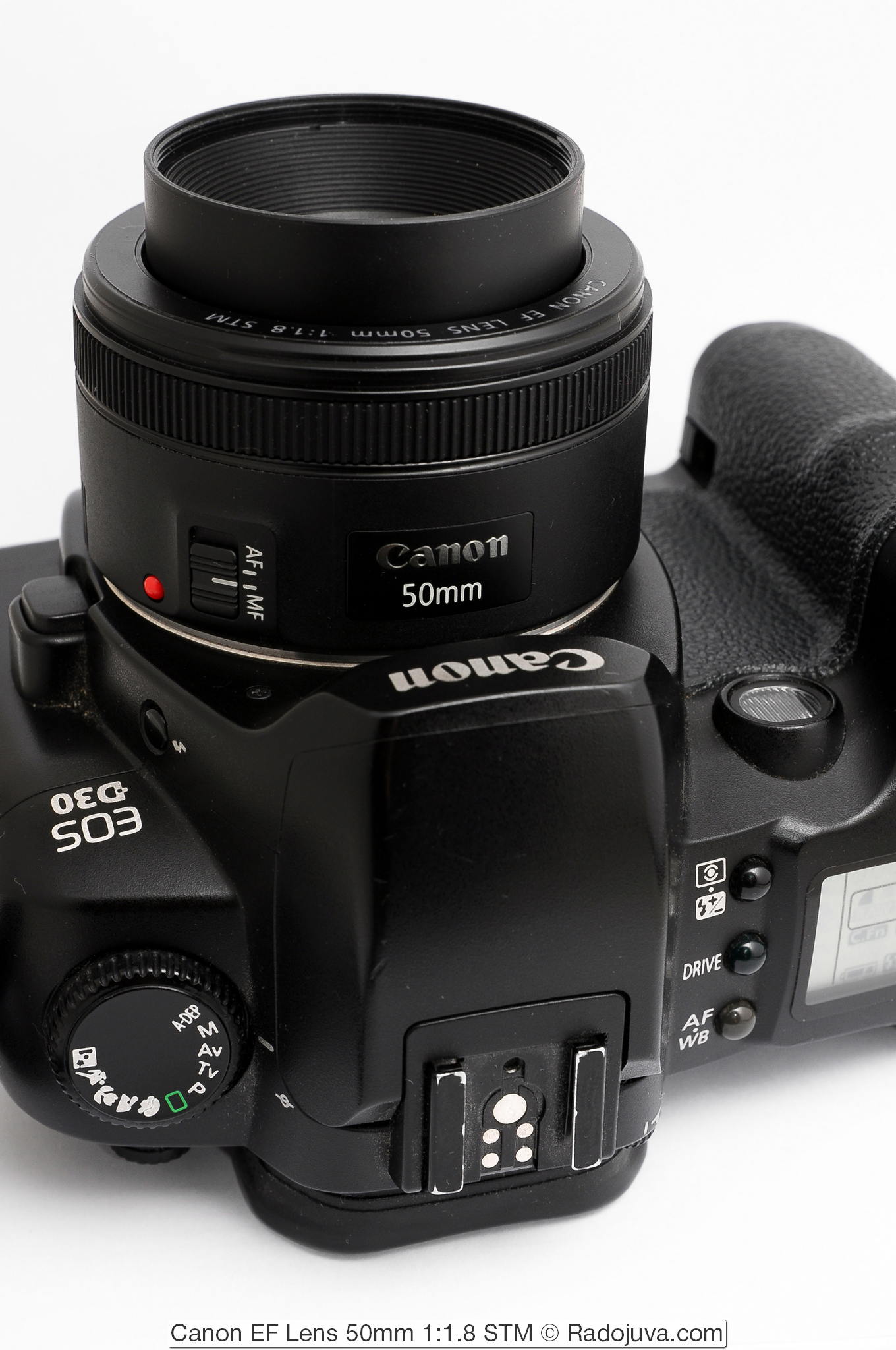
Canon EF Lens 50mm 1: 1.8 STM on-camera lens Canon EOS D30. The lens is focused at a distance of 35 cm, the trunk of the lens is extended to the maximum
Sample Photos
The Canon 50 / 1.8 STM was purchased by me to resolve one dispute - whether new lenses, such as this one with an STM motor, are still compatible with older Canon EOS cameras. As it turned out, the system Canon EOS very good and compatibility is supported even by old autofocus film cameras.
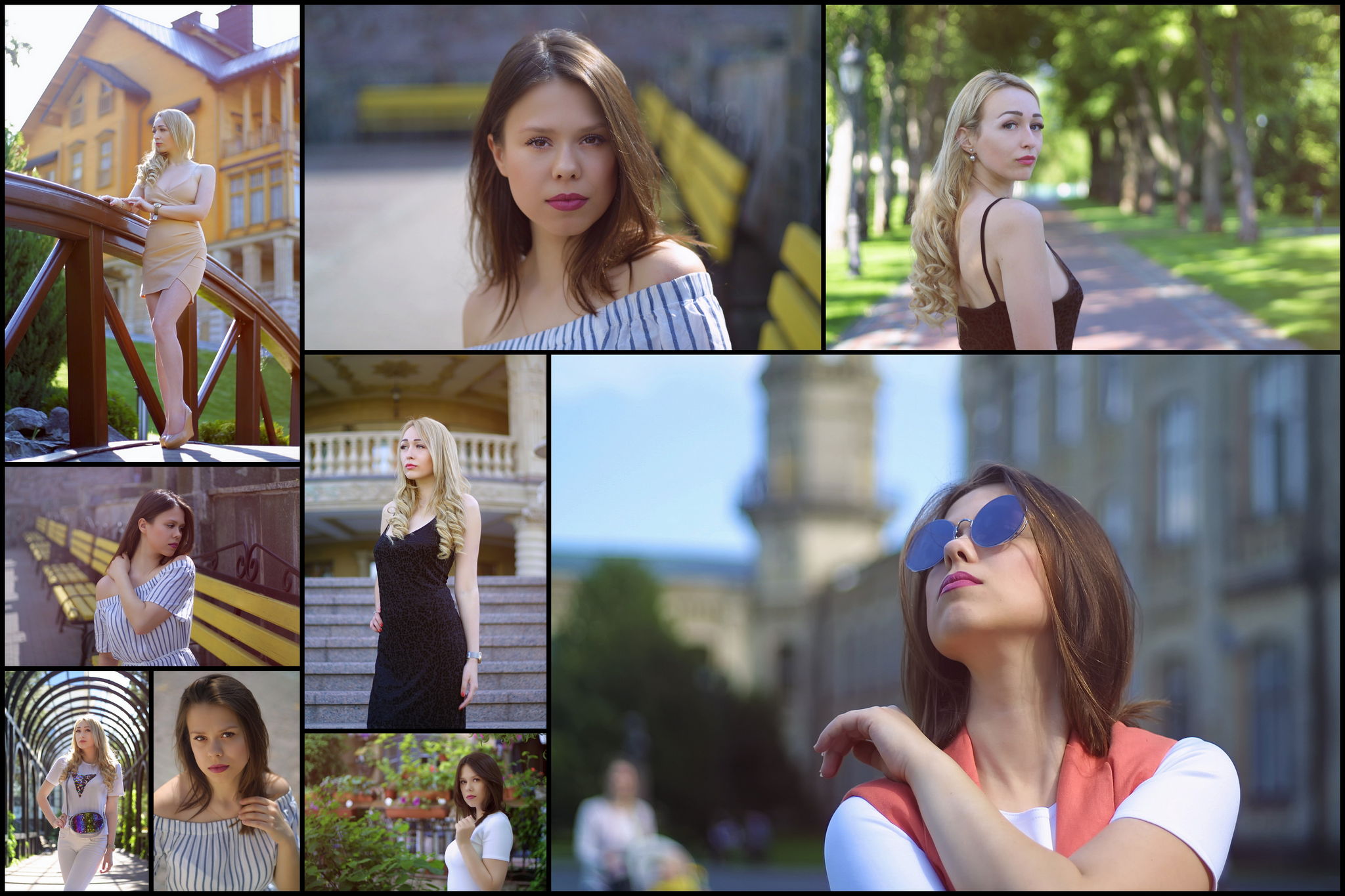
Examples of shots on the Canon EF Lens 50mm 1: 1.8 STM can be viewed here to register:. increase.

Examples of shots on the Canon EF Lens 50mm 1: 1.8 STM can be viewed here to register:. increase.
Original RAW ('.CRW') or JPEG files can be download from this link.
Work with Canon 50 / 1.8 STM on Canon 550D / 5D Mark III is too boring and simple. Therefore, only in Radozhiv you can look at the photo with a Canon 50 / 1.8 STM installed on the first digital SLR camera from Canon, produced in 2000. Photos can be viewed in my gallery on 500PX.
Alternatives
Below is a list of fifty-fifty lenses and lenses that are very close in their focal length to 50 mm, which support auto focus and are suitable for full-frame cameras Canon EOS.
Canon:
| Canon Lens EF 50mm 1:1.8, version with a focusing distance window and metal mount | March 1987 | View price |
|
Canon Lens EF 50mm 1:1.8 II, the second version without a window of focusing distances and a plastic bayonet mount. This lens exists in two subversions: Subversion fundamentally no different |
December 1990 | View price |
| Canon EF Lens 50mm 1:1.8 STM | May 2015 | View price |
| Canon EF Lens 50mm 1:1.4 Ultrasonic | July 1993 | View price |
| Canon EF Lens 50mm 1:1.2 USM Ultrasonic | January 2007 | View price |
| Canon EF Lens 50mm 1:1.0 l Ultrasonic | September 1989 | View price |
| Canon Compact macro Lens EF 50mm 1:2.5 | December 1987 | View price |
| Canon lens RF 50 mm F1.2 L USM | September 2018 | View price |
Tamron:
| Tamron SP 45mm F /1.8 Di VC USD F013 | September 2015 | View price |
Sigma:
| Sigma 50mm 1:1.4 DG HSM EX, this lens exists in two versions with a different type of body coating | March 2008 | View price |
| Sigma 50mm 1:1.4 DG HSM A (Art) | January 2014 | View price |
| Sigma 50mm 1:2.8 Macro | 1990 | View price |
|
Sigma 50mm 1:2.8 Macro EX, there was a copy of this lens under the name Quantaray 50mm 1:2.8 Macro |
1998 | View price |
| Sigma 50mm 1:2.8 DG Macro EX | June 2004 | View price |
Tokina:
| Tokina Opera 50mm F1.4 FF | February 2018 | View price |
Yongnuo:
|
There are several sub-versions with different spelling of the name near the front lens
Subversion fundamentally no different |
December 2014 | View price |
|
There are two options, depending on the color of the case: the black or white |
May 2018 | View price |
| Yongnuo Lens 50mm 1:1.4there was another prototype Yongnuo Lens EF 50mm 1:1.4 | May 2018 | View price |
Difference between Canon 50 / 1.8 STM and Canon 50 / 1.8 II
Below I will indicate the main differences between the lenses:
- Canon 50 / 1.8 STM is a newer lens, introduced in May 2015. Canon 50 / 1.8 II was introduced much earlier - in December 1990.
- The Canon 50 / 1.8 II uses a regular humming micromotor to focus. Canon 50 / 1.8 STM has an advanced stepper motor that is very quiet
- Lenses have different minimum focusing distances. The Canon 50 / 1.8 STM focuses up to 35 cm, and the Canon 50 / 1.8 II only up to 45 cm. As a result, small objects are easier to shoot with the Canon 50 / 1.8 STM
- The Canon 50 / 1.8 STM has better clarity, optimized for working with digital cameras. Canon 50 / 1.8 II is optimized for film cameras (nevertheless, it works well with digital cameras)
- The Canon 50 / 1.8 II uses only 5 non-rounded aperture blades, which adversely affects discs in the blur zone. The Canon 50 / 1.8 STM uses 7 rounded lobes, which is why it has more even and beautiful discs in the blur zone (the bokeh of the Canon 50 / 1.8 STM on covered diaphragms is more pleasant)
- Canon 50 / 1.8 STM is 30 grams heavier
- Canon 50 / 1.8 STM uses metal mount, Canon 50 / 1.8 II uses plastic
- Canon 50 / 1.8 STM uses an electronic focus ring, Canon 50 / 1.8 II uses a mechanical focusing ring.
- Canon 50 / 1.8 STM supports FTM mode. But Canon 50 / 1.8 II for manual focusing must be switched to 'MF' mode.
- The first Canon 50 / 1.8 II lenses were made in Japan (subversion Canon Lens EF 50mm 1: 1.8 II Canon Lens Made in Japan), and subsequent in Malaysia (subversion Canon Lens EF 50mm 1: 1.8 II Canon INC. Made in malaysia) All Canon 50 / 1.8 STM lenses are manufactured exclusively in Malaysia (Canon INC. Made In Malaysia on the side of the mount)
- Focus speed of the Canon 50 / 1.8 II is higher than that of the Canon 50 / 1.8 STM
- Canon 50 / 1.8 II uses a hood that is screwed into the filter thread and cannot be installed in the opposite direction for transportation (in fact, if you need an original hood for Canon 50 / 1.8 II, then you need to use a clever combination of ES-62 hood with small Hood Adapter 62. The new Canon 50 / 1.8 STM uses a more modern method - a bayonet hood that fits into special slots located on the lens barrel
- The Canon 50 / 1.8 STM uses a diameter for 49 mm filters, and the Canon 50 / 1.8 II 52 mm. The latter is more common and it is a little easier to find filter filters for it.
Important: I have quite a lot of experience with Canon Lens EF 50mm 1: 1.8, Canon Lens EF 50mm 1: 1.8 II (used with dozens of different instances of this mass lens) and YONGNUO LENS EF 50mm 1: 1.8... Between them and the new Canon 50 / 1.8 STM, I didn't feel any difference in image quality. This is most likely due to the same optical design of these lenses. This conclusion is indirectly confirmed by MTF charts for Canon Lens EF 50mm 1: 1.8 II and Canon 50 / 1.8 STM.
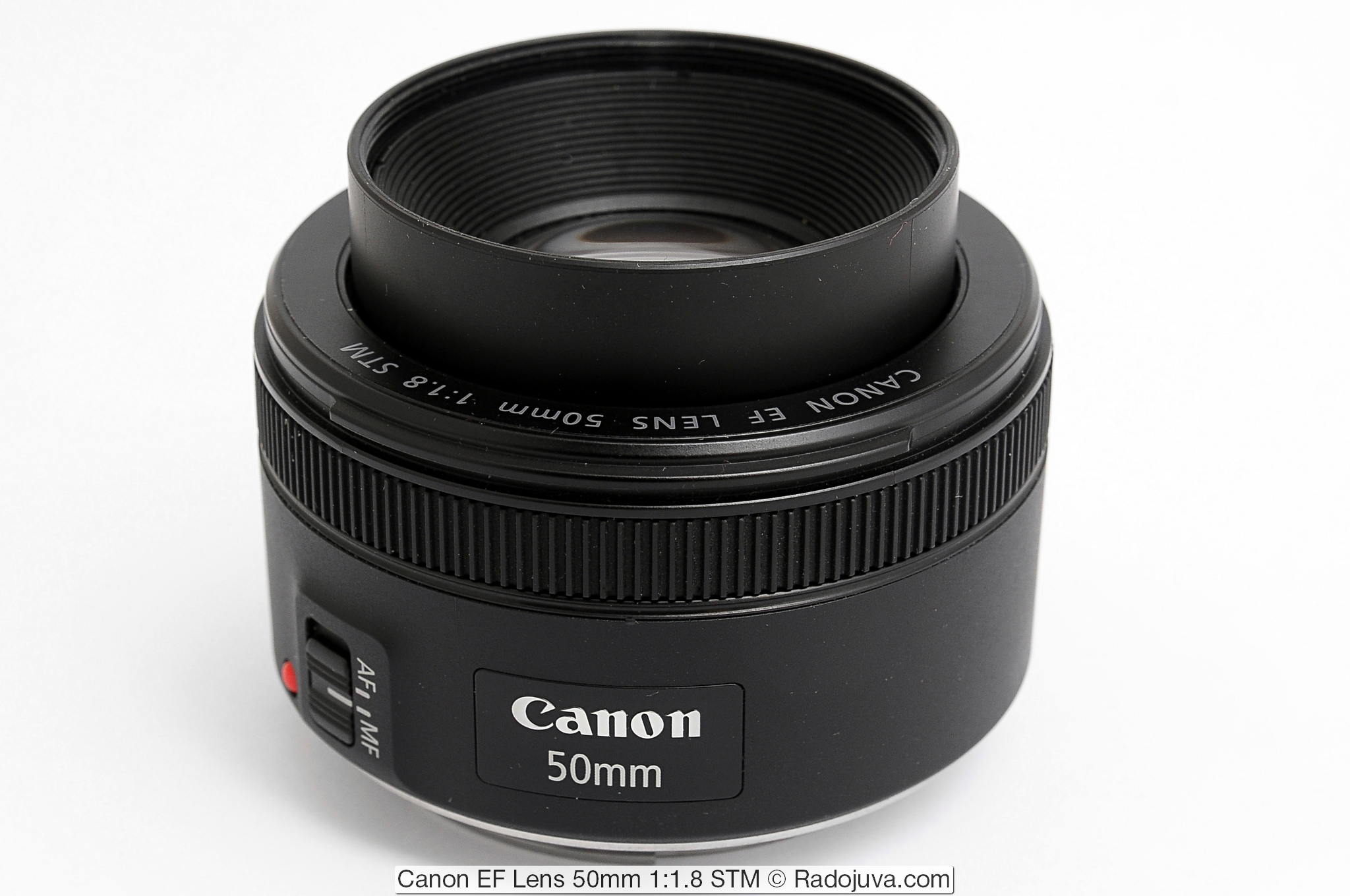
Canon EF Lens 50mm 1: 1.8 STM. The maximum length of the retractable rim of the body (trunk). Focus on MDF
My experience
Canon 50 / 1.8 STM - simple / budget fifty dollars. There is not much to talk about here. You have to buy and rent.
On cameras with an APS-C sensor (Kf = 1.6x) it is often used as a portrait and creative lens. On full-frame Canon cameras (Kf = 1x) and Canon cameras with an APS-H sensor (Kf = 1.3x), it can serve as a regular prime lens for every day.
Personally, I would prefer used. Canon 50/1.4 USM before the new Canon 50/1.8 STM. Also the first version Canon Lens EF 50mm 1: 1.8 I like it more than the Canon 50 / 1.8 STM and Canon Lens EF 50mm 1: 1.8 II. I believe that USM motors in many photo tasks are still preferable to STM motors. STM is more suitable for those who shoot a lot of videos with auto focus.
Recently, I still consider the best budget fifty for amateur photographers YONGNUO LENS EF 50mm 1: 1.8. Often, a fifty dollars is bought to just 'play around' with aperture optics. YONGNUO LENS EF 50mm 1: 1.8 for 'games' with F / 1.8 will be enough for the eyes. If you need fifty dollars, say, for work, or for more serious things than amateur photography, then the Canon system has several other solutions with F / 1.4 and F / 1.2.
The Canon 50 / 1.8 STM often serves as a starting point in the world of professional photography. Almost all novice photographers and amateur photographers pass through 50 / 1.8 class lenses sooner or later, and it’s very good that the Canon 50 / 1.8 STM turned out to be what it is.
Prices
Lens prices are available see here.
Comments on this post do not require registration. Anyone can leave a comment. Many different photographic equipment can be found on AliExpress.
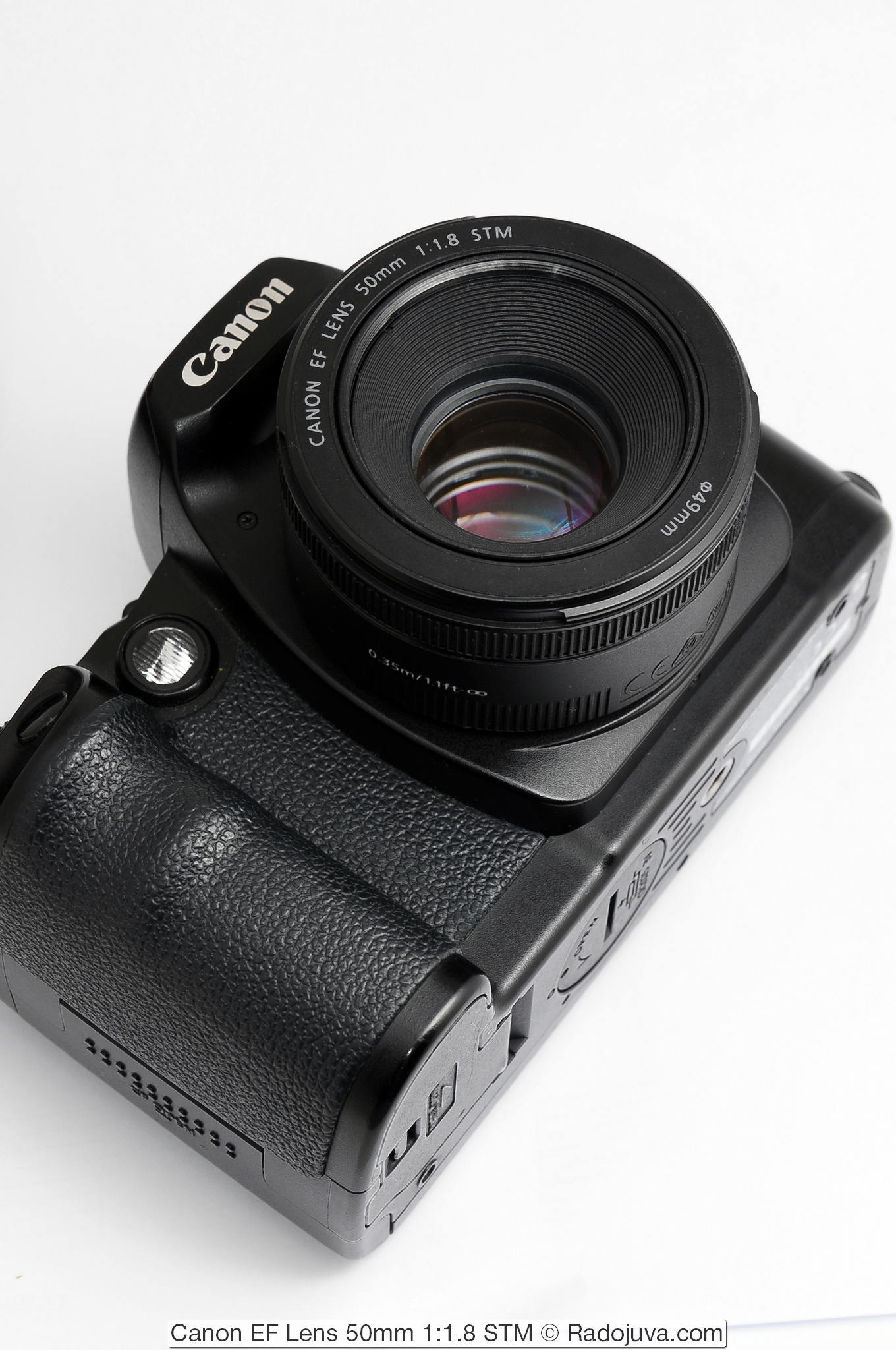
Canon EF Lens 50mm 1: 1.8 STM on-camera lens Canon EOS D30
Results
Canon EF Lens 50mm 1: 1.8 STM is a balanced lens. The ratio of price, build quality and image quality is at a very good level. One of the few lenses that can be safely recommended to almost all amateur photographers shooting with Canon SLR cameras.
Advantages
- low cost (this is one of the cheapest original autofocus lenses for SLR cameras with Canon EF / EF-S mount)
- high aperture
- STM stepper focus motor (very useful during movie shooting, makes focusing smooth). Compatible with all Canon EOS Digital Cameras
- light weight, compact size, small diameter for filters
- good assembly: plastic that is pleasant to the touch, metal bayonet mount, bayonet type hood, hood is attached to the body (not to the trunk)
- small MDF and, as a result, a good maximum magnification factor during macro photography. For most of these fifty dollars this indicator is worse
- lack of rotation of the focus ring during auto focus
- FTM continuous manual focus control
- the active focus ring rotates about 180 degrees, making manual focusing comfortable enough
- the filter frame does not rotate during focusing
- Compatibility with older cameras (e.g. stepper motor lenses) Nikon AF-P lost compatibility with cameras older than 2012)
- no focus shift
- rounded aperture blades, fairly rounded aperture at values from F / 2.0-F / 5.6
- good / good optical performance, including confident sharpness at F / 1.8 in the center of the frame
Disadvantages
- there is no focus distance scale, depth of field scale and a mark for working in the infrared spectrum, although they were still in the first classic Canon Lens EF 50mm 1: 1.8
- There are unpleasant features of working with the electronic (electromechanical) focus ring: the ring is inactive with the metering turned off, in manual mode the ring consumes electricity. Manual focus does not work at all with the camera turned off and minor troubles associated with such behavior
- the function of constant manual focus control FTM has many nuances and in the general case is not very convenient and practical and is much worse implemented than, for example, a similar function M / A with a similar lens Nikkor 50 / 1.8G from Nikon camp
- focusing speed in the normal focus mode using phase focus sensors is average and significantly lower than that of Canon 50 / 1.8 II
- slight noise from the focus motor in auto focus mode. Unpleasant, although not very loud, noise during manual focus
- during focusing towards MDF, the front of the frame (trunk) moves forward
- no hood included
- there is no basic dust and moisture protection, the focus ring is not rubberized
- small effect of 'Focus Breathing' (changes in viewing angle during focusing)
- the aperture at F / 5.6-F / 22 is poorly rounded and is a regular heptagon
- slight imperfections in the image: poor resolution at the corners and edges of the image on open apertures, noticeable vignetting on open apertures, glare in backlight
- the optical scheme is not updated and copies the optical scheme from previous lenses Canon Lens EF 50mm 1: 1.8 и Canon Lens EF 50mm 1: 1.8 II, the first of which was introduced back in 1987
Update: A review of an inexpensive analog has appeared - YONGNUO LENS YN50mm F1.8 II.
Material prepared Arkady Shapoval. Training/Consultations | Youtube | Facebook | Instagram | Twitter | Telegram

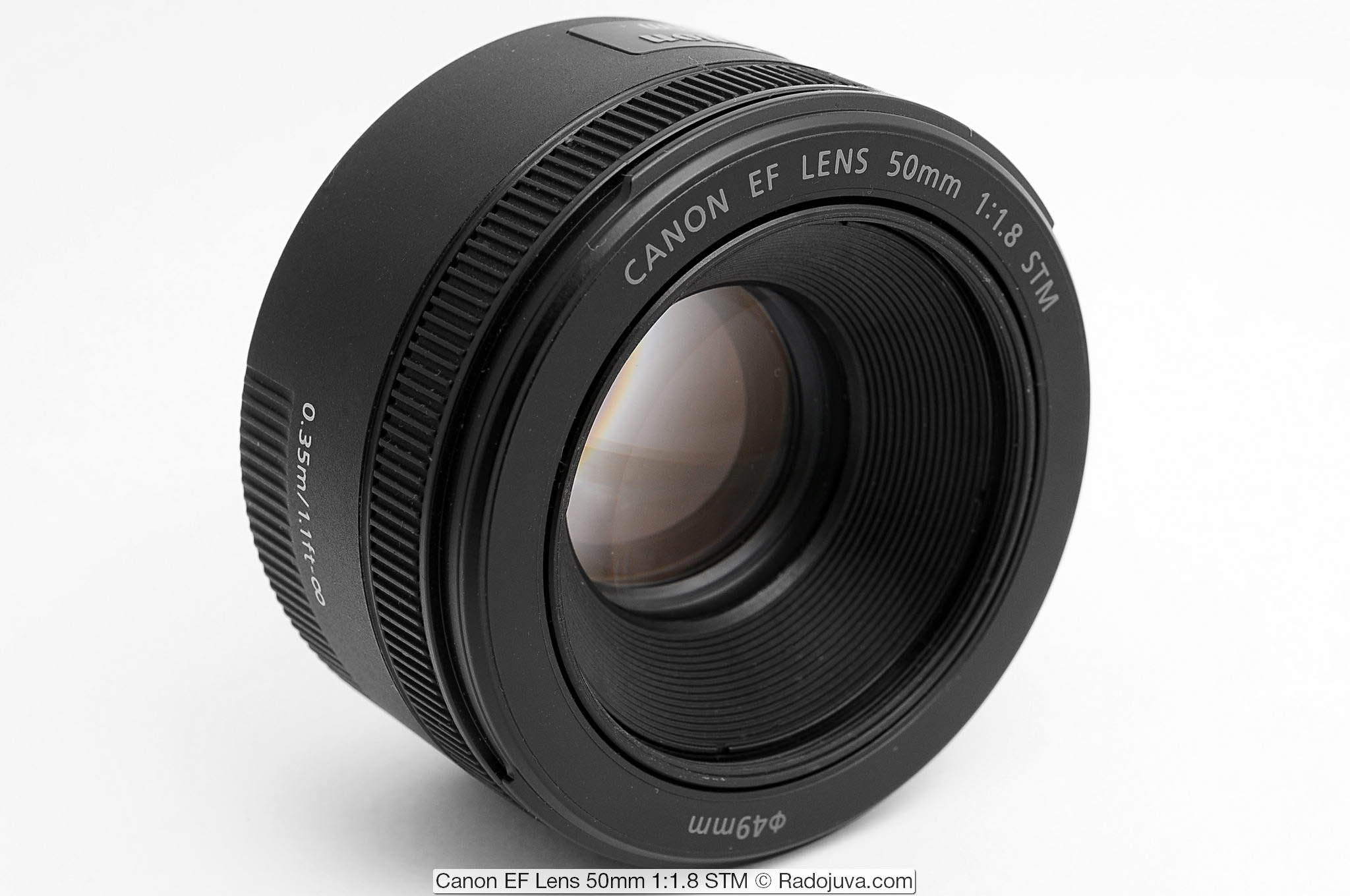

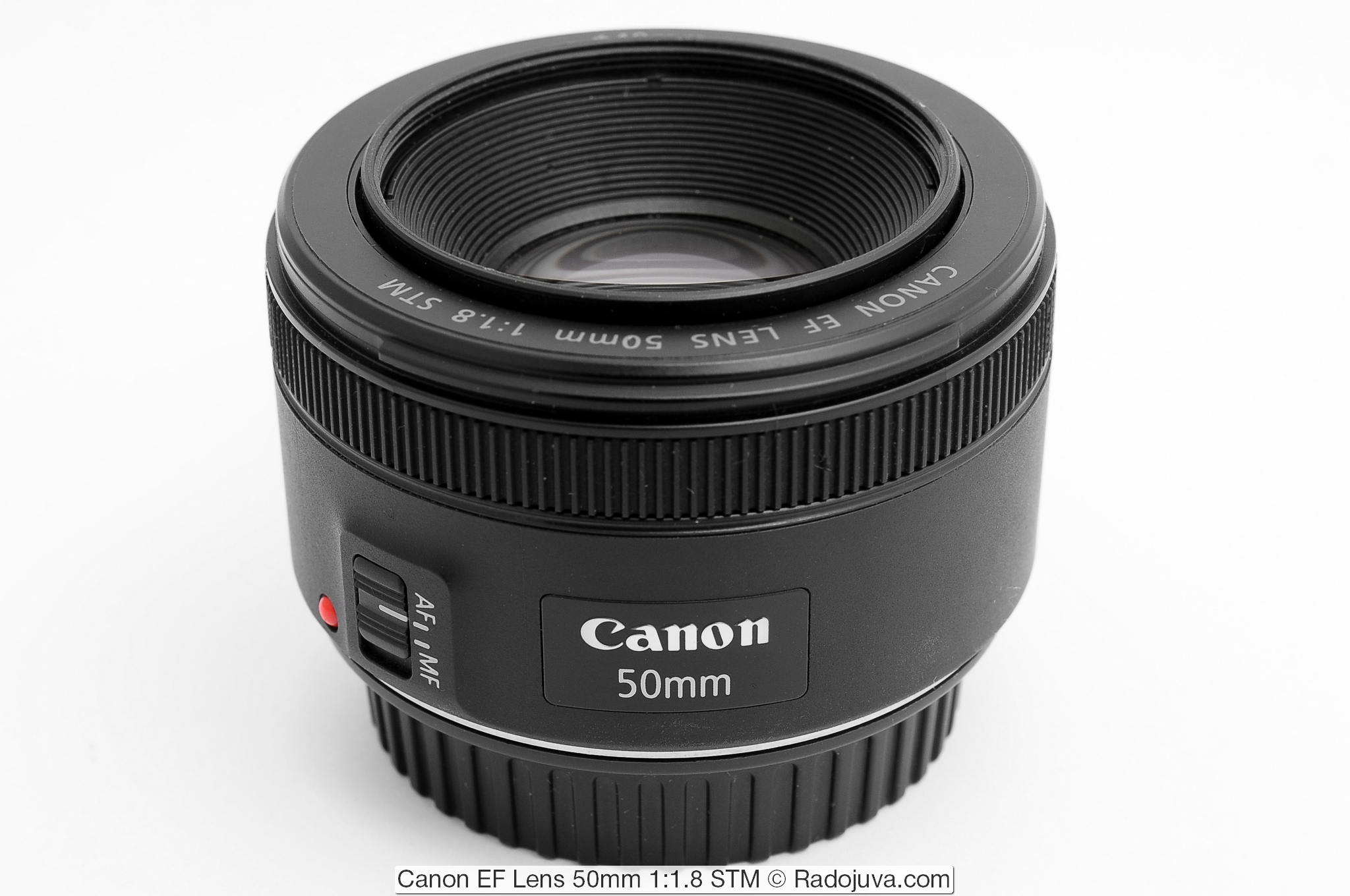
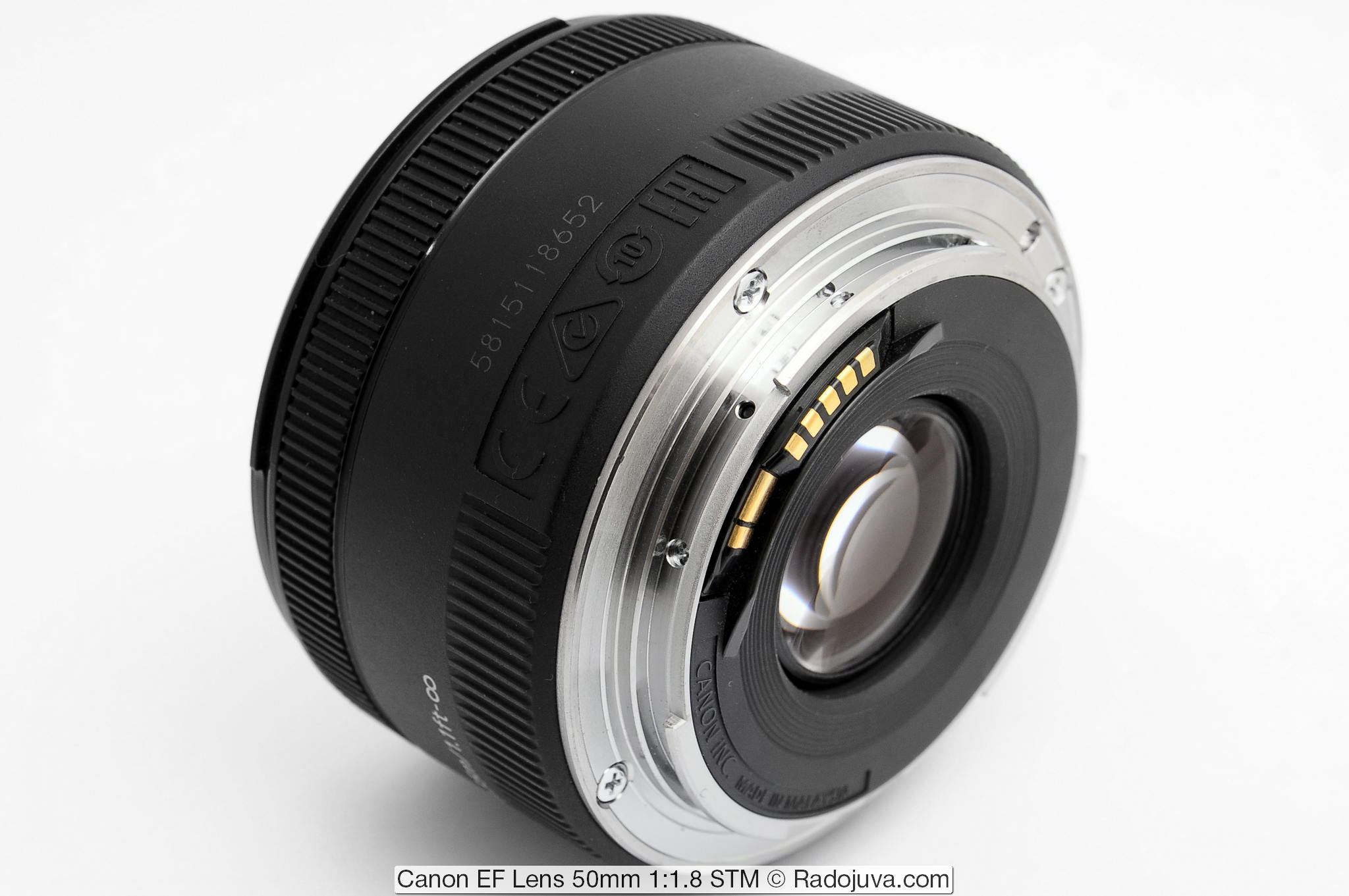
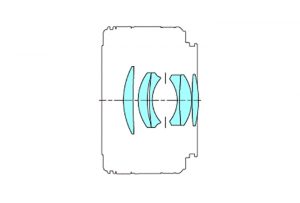
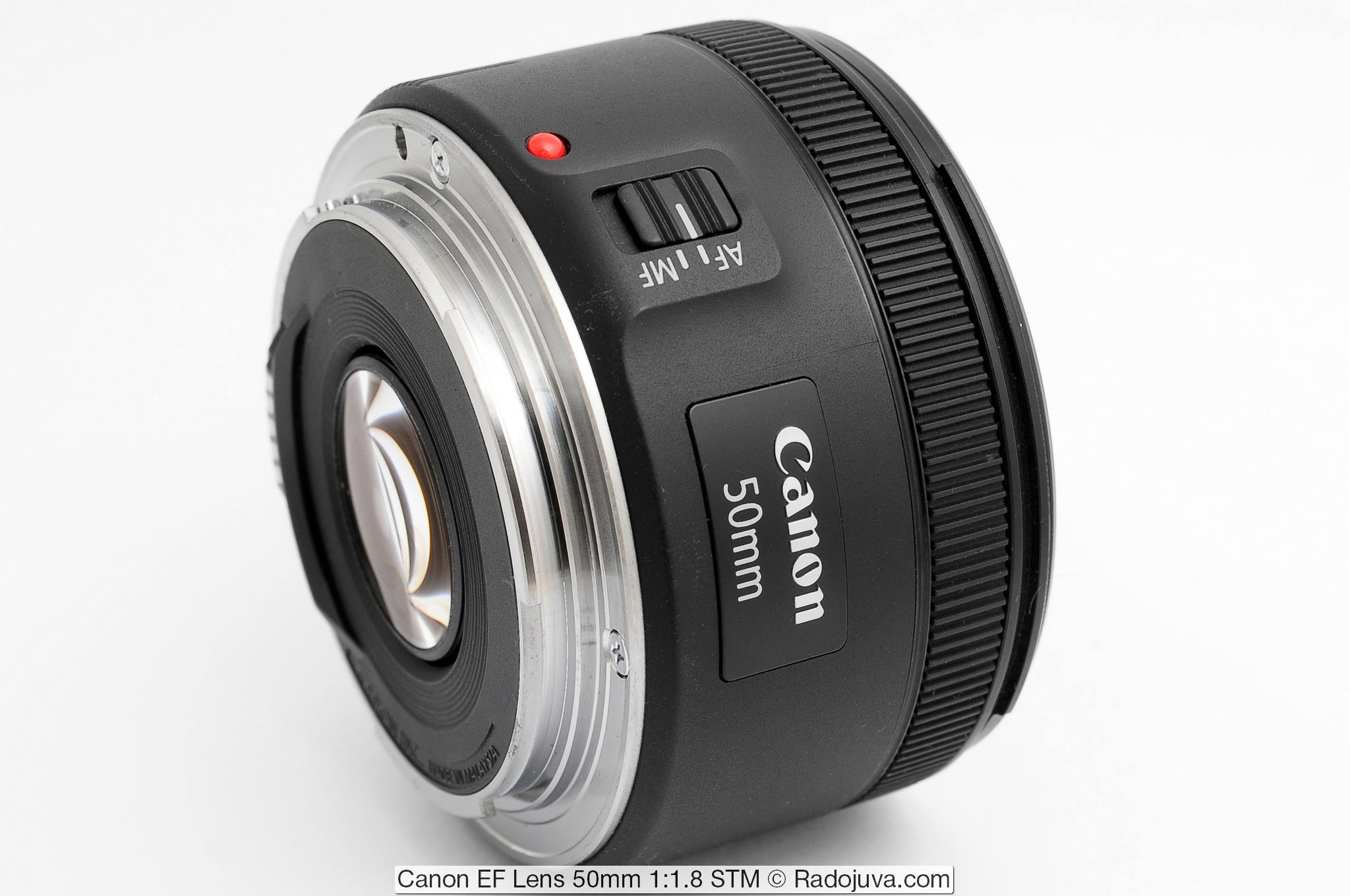
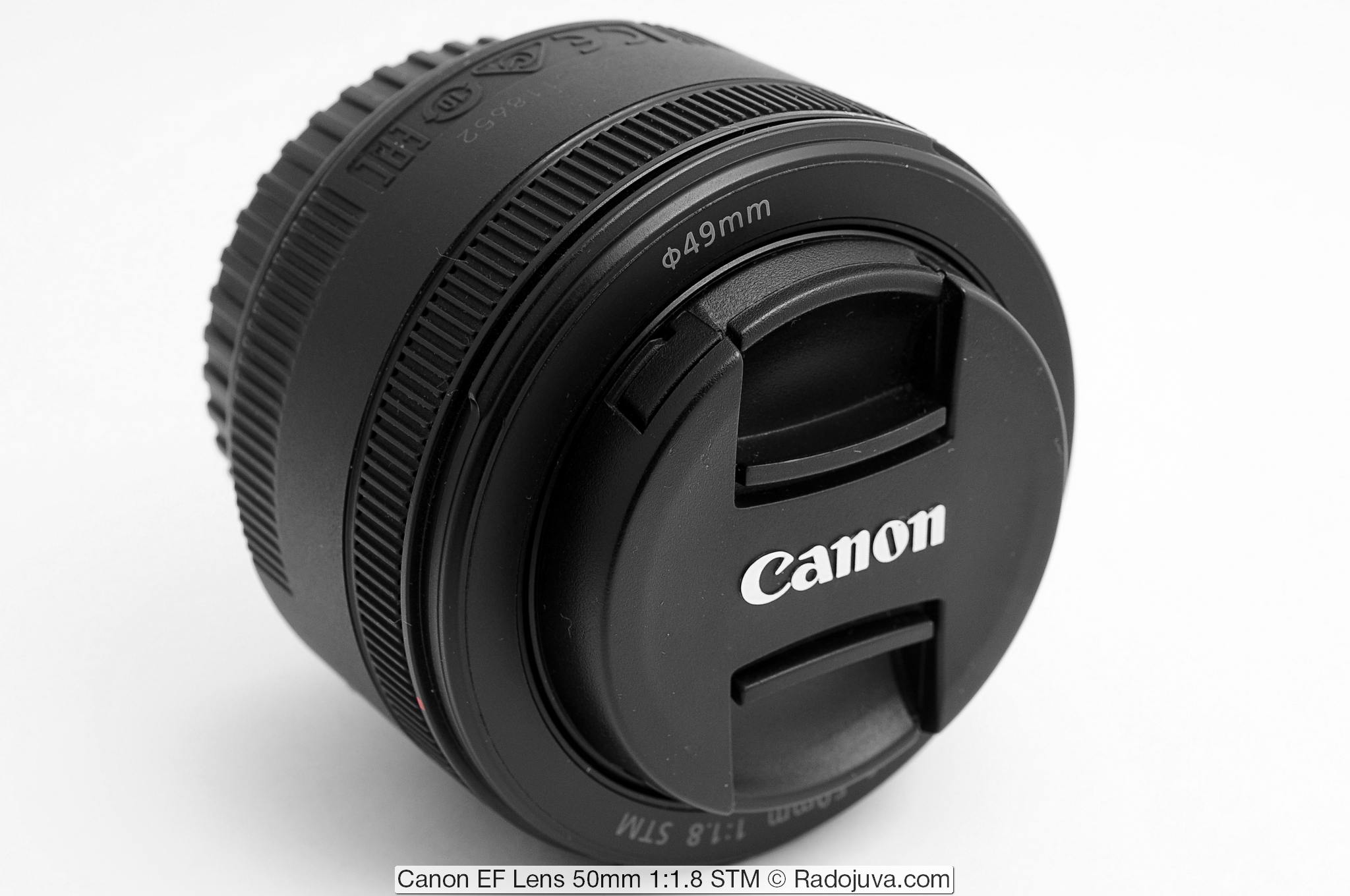

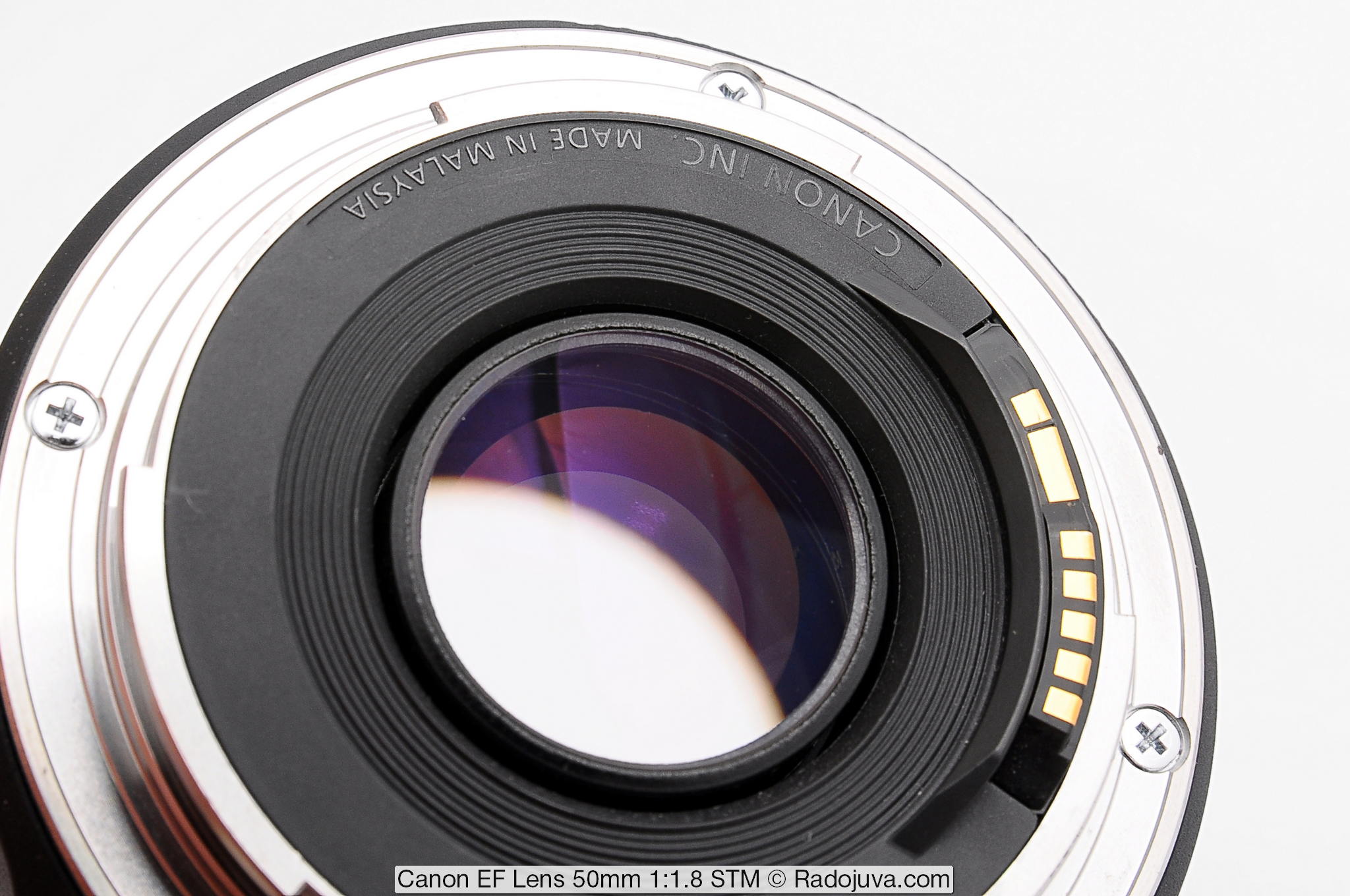
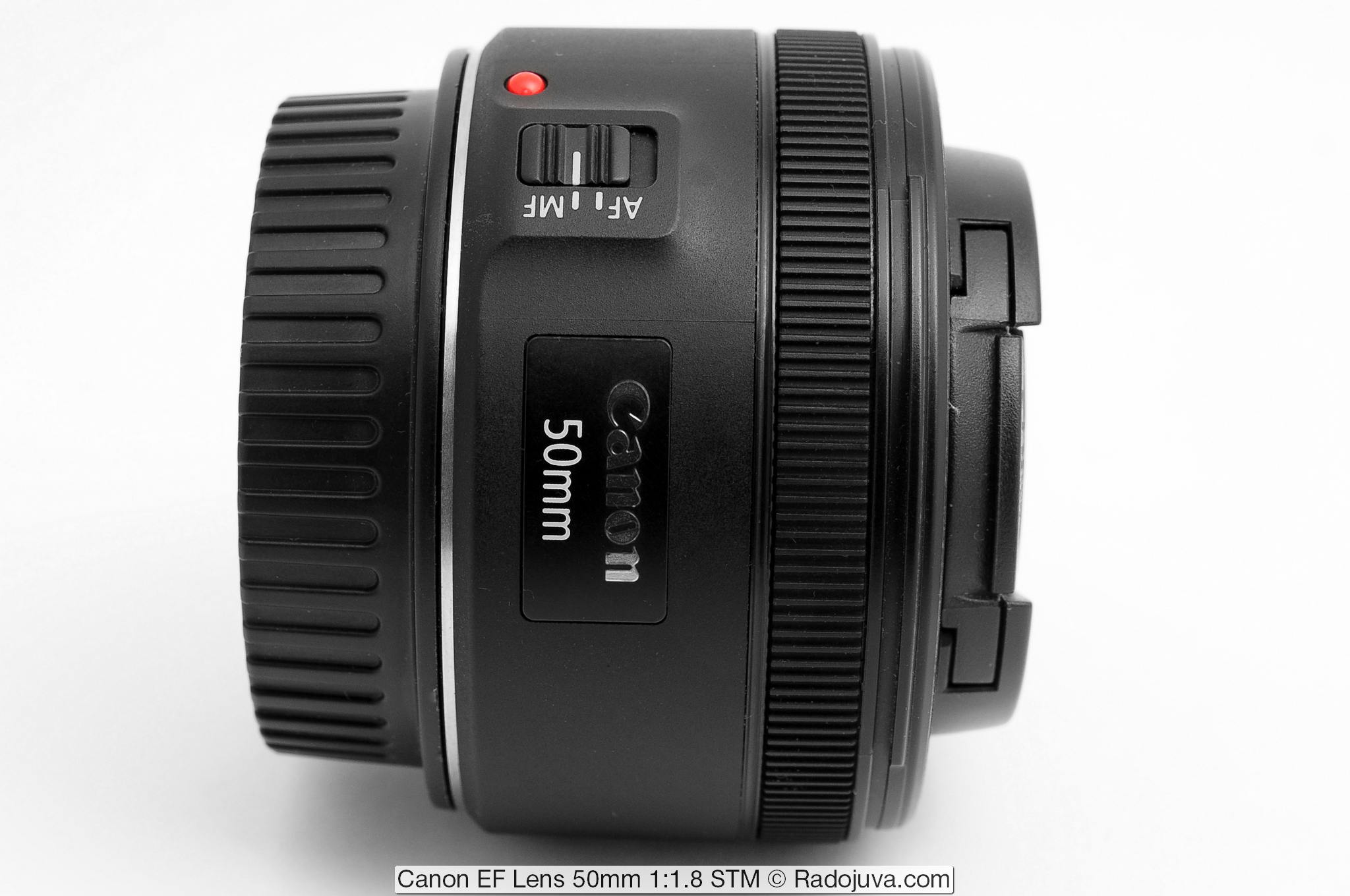
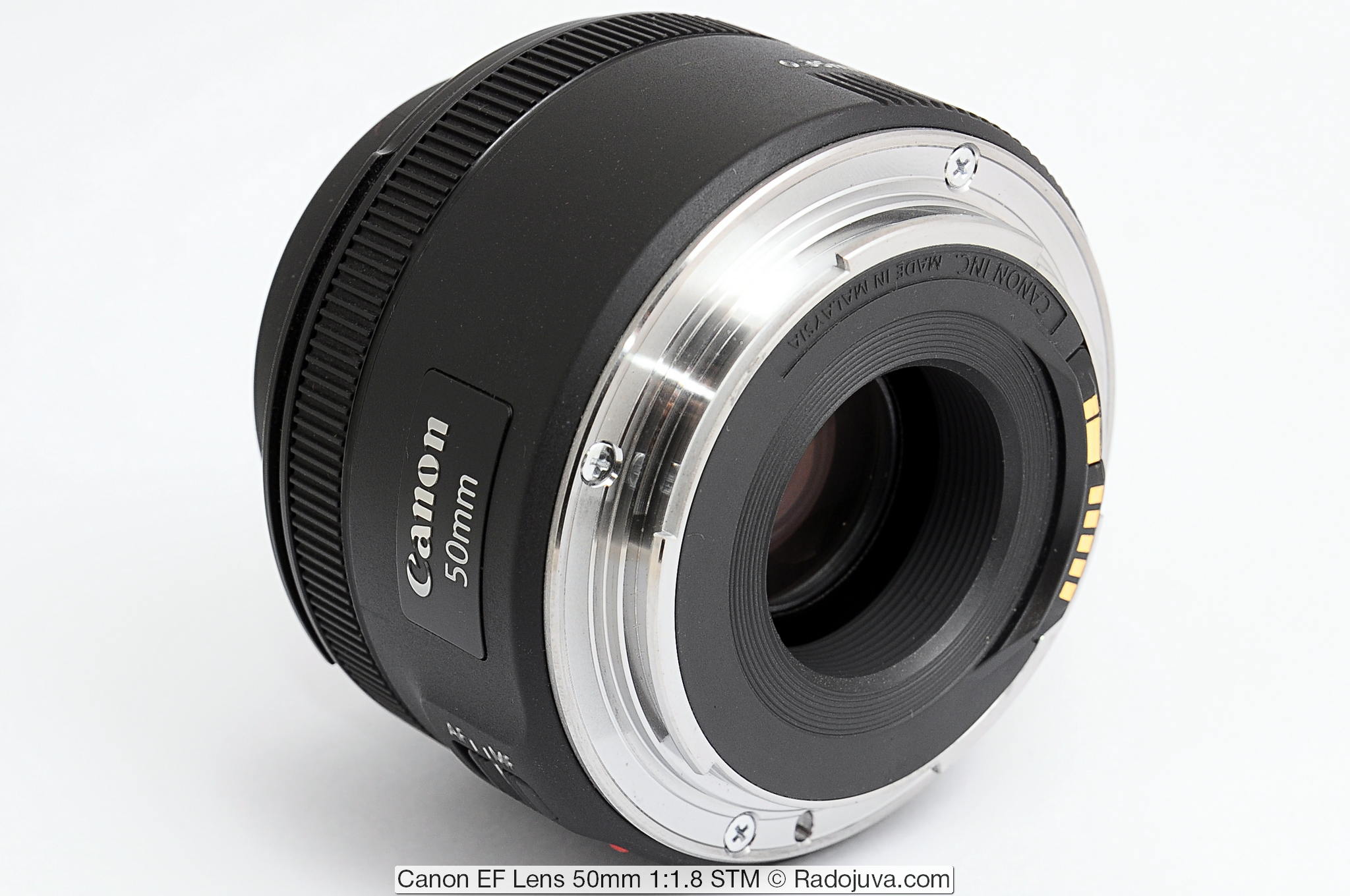
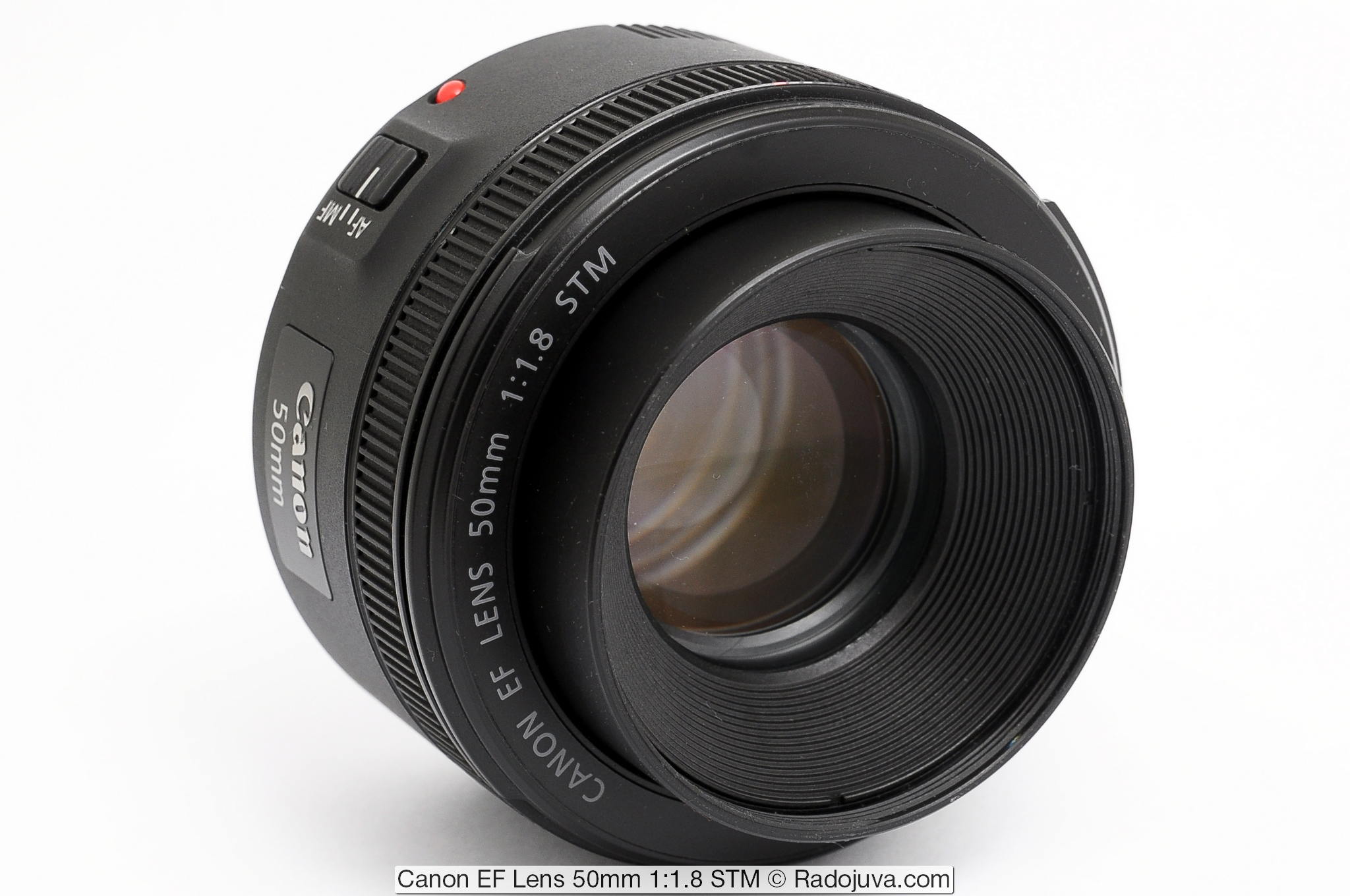

Well, let's say this: it's better than helios)
Almost anything is better than helios)
I support)
What is better hamer or Lada?
And if you need to drive into the sash with a width of 1,7 m?
And in which case do you need to go to Helios?
in ten-bucks
Gold words))). Only sometimes it's easier to get through ...
Autofocus is better?
Sharpness on open weight. Bokeh is not so cute, simpler, but heliosovskoe quickly bored. However, if you shoot and process at least like this: https://500px.com/leks-a , then Helios is quite a lens (although the latest photos on Zenitar 0,95).
“… I still think the Chinese YONGNUO LENS EF 50mm 1: 1.8 is the best budget fifty dollar for amateur photographers.” - is it quite seriously written?
yes, there is further explanation, you can also quote it. Moreover, this is from the section "my experience", my experience may differ from yours and this is normal :) And if there are other comments on the review, I will be glad to your opinion :)
By the way, the second version of the yang fifty
Thanks. He was here in the list of alternatives from the very beginning, and was also added to the list of all YN lenses on the day of the announcement.
STMs work not only with digital cameras, but also with film cameras. I shot 2.8 / 40 on film EOS-30 with success.
Special thanks for the D30 - I watched the work with great interest!
Was with me. AF smears. I read - they have a disease.
Thank you for the detailed review and comprehensive information. Maybe I’ll get one just for the video. For now, I’m using the first version of Kenonov’s fifty dollars f1.8 and I’ll also write that the first version is much more reliable than the second.
Grandpa is very good. Just one fly in the ointment - 5 petals :)
I think it's the best 50mm 1: 4 from Canon! I have this one - copes with shooting in clubs in low light. Take it, you won't regret it!
can I see pictures in the club in low light?
For me, the ISO stock is more useful. all the same, the diaphragm will have to be covered due to a narrow flu.
I think the best sigma art 50 1.4 and tamrik 45 vc
Sigma has many complaints about autofocus.
Tamron simply has an inadequate price.
Complaints about autofocus, according to my observations, on Canon cameras. I personally, as the owner, have no complaints. This is at least ...
I have a Kenon camera and two Sigma lenses. There are no complaints about 105 2.8. 30 1,4 smears on open if further 5m, with 2,2 standards.
"Like the owner of complaints" - very amused - could not resist)))
And on Sigma - here as a chip will fall. My D300 DC 30 Art did not start, but I use old ones, ok.
According to Sigma AF 50mm f / 1.4 DG HSM Art Canon EF, there seems to be no complaints about autofocus.
It focuses accurately and steadily from aperture 1.4.
I know from my experience and reviews of other owners.
Moreover, the focus for Art lenses can be adjusted through the dock, but did not hear that such a need really arose.
Other Sigma lenses that are not part of the Art series could have problems with autofocus, they have different 50 mm f / 1.4, do not confuse them.
I consider the best tops from Zeiss if handles and from Boot if cars))). But where does the 50 1.8?
Arkady smart!
Serves people)
Excellent review, thanks for fifty dollars and for serios)
Photos at a height, given what was shot ...........
Wow :) a person doesn’t complex to shoot 3 MP. And it’s good, but if it’s better to poke fun, then you can give out for 5dsr !!
By the way, I looked about 30d ... Fantastic! The beginning of the century))). I started sometime with 400ki and here it is. And nothing, by the way, is 3 mega in the hands of a specialist eba.at cleaner than many FF from local talkers. Cool. I went to charge 400ku)
Rather, D30 (30D is already completely different)
Oh and licked ..
I agree a great review!
Thanks for your work!!!
Arkady, thank you for the detailed review! Few examples of photos were missing. Found here with shooting options http://onfotolife.com/lens_sample_photos?lens_id=110&language=ru&page=1&focal_min=0&focal_max=800&aperture_min=0&aperture_max=32
And in truth there are excellent "parameters"! )
Very unhappy with my m lens. It only worked for about 12 months, they auto focus stop working. I took it back to shop and the technician told me that this is a general fault on the canon lenses!
Miser pays twice. Here it was recommended.
About yongnuo I agree. When I didn’t have fifty, I shot at 35mm and 50mm, first at 1dm4, then at 1dx - all zbs on open holes, oily bokeh, fast focus (shooting sports) despite the fact that there was no drive and it was very buzzing. 3.5 are the same as the original. But they lose to fixes from Nikon of the same fr: 35/2 and 50 / 1.8d. I advise some commentators to take their heads out of their own ass and shoot more with their own hands than read the nonsense that they write about yonhnuo.
You worked on 1DX fixes Yongnuo?!)
Morning definitely succeeded.
if you shoot on your phone - why can't you shoot on yonhnuo
Arkady, hello! Tell an amateur, please, is this lens suitable for shooting a portrait of dogs and dogs in full growth, if they do not jump, but stand and, say, perform micromotions without end? if you put together the canon 800d, will they cope together? and what to do with the light? when it's warm - you can shoot on the street, and when it's cold - you probably need to equip some kind of light in the room ... in general, a question about this lens)))
Hello. I recently purchased this lens. I like the picture. I am not a professional and I have a question. The 18-55 is whale lens is no longer needed or may it still be needed for some tasks?
It will be needed, even as needed because of the wide viewing angle
Thanks for the answer
Ordered fifty dollars STM) for daughter))
good adequate optics and for adequate money. I took the first photos at the shift of 8m and zenith ET as a photo corr. back in the 90s.
Friends, - only you take a photo - Create !!!
Can you tell me how it autofocuses with macro rings? And can it be considered as a budget replacement for a real macro lens (a set of rings - 13, 21, 31 mm - is already available)? With 18-55mm f / 3.5-5.6 III and a 13 mm ring, I was able to take photos more or less tolerably with a magnification of ~ 0,7x (autofocus does not work with a larger elongation, and the bees are not going to wait until you spin the focus manually).
A bit better. The more rings, the worse the focusing, the aperture decreases with each ring, and it is inconvenient to bring it with your hands - a very narrow ring. It is still better to look towards 60 / 2.8, although focusing works very poorly there with macro rings.
In general, the lens is very decent, but specifically for macro objectives, in comparison with the whale, you will not gain much. For a normal macro, you need to press a hole, otherwise nothing will fall into sharpness. Perhaps even 55-250 is better for this, if only due to the fact that you can move away with the same size of the object - not to scare your bees away.
Thanks for the review!
Norod, good day!
Today I bought this "miracle" .. and literally from the first shots - disappointment! Can someone explain where such wild HA come from? what should I do with it? can hand over, before it's too late, back to the store? Here is an example of a photo (in the zip archive zpeg and rav):
https://www.dropbox.com/s/jhq7pd2le8e9d5g/a_sample.zip?dl=0
Yes, here is also the third day I ask this question. On many frames with aperture 1.8, chromatic aberration simply cuts the eyes.
At a "small level" does not pull. In general, I see this for the first time (after 18-55 f / 3.5-5.6 III and 18-135 f / 3.5-5.6 IS STM).
Googled, on the forums the majority claims that the lateral HA in this lens is supposedly absent. But in the photo what is it? - https://yadi.sk/i/kIvf252xANacHg
And about the green-purple bokeh, I found a statement that supposedly this is a feature of ALL high-aperture lenses, including L-ki. Something is doubtful ...
Can this lens be advised as an optimal purchase for a novice artist for shooting ready-made paintings? The tasks for the lens are just these, the budget for buying a camera and optics is small. Thanks in advance.
Yes, it is quite
Hello! I have a kind of illogical choice: buy a Canon 50 1.8 STM for a full frame, or a 50 1.4 sigma art. Obviously sigma is better (and much more expensive). But, when comparing the MTF graphs in the Photozone, I saw that at f4 - 8, the lenses show the same resolution. I would like to know if the pictures on these "holes" will be VERY different. A mystical "drawing" (like a sigma) can be done by whatever you want in post-processing, right? I think Sigma Art is good at open apertures, hence the excitement.
If you just need a fast fifty dollars, Canon is more than enough. If you plan to make this fifty dollars one of its main lenses, of course, Sigma is cooler, faster, and sharper (it’s a direct competitor to 1.2L).
At f8 and, IMHO, even at f4, the difference that post-processing gives will be much more significant than the difference between the lenses. That is, the lack of plot and lighting will not be corrected by the “drawing”.
What does the plot have to do with it? A priori, the scenes and conditions are meant to be the same when shooting with these lenses. We are talking about post-processing images with the same RESOLUTION, but from different lenses. The main thing is detail, and colors, contrast in the editors can be changed as you like, and so-called. FIGURE is generally a relative concept - it is provided by a camera JPG, but in RAW everything is erased, everything drags on, everything changes. I’m not a dog in these matters, I just want to understand the difference with your help. I once wanted to buy 50 1.8 STM, I shot at a target in a store (there were continuous misses in focus - there was a back, as it turned out later, went out into the street, took pictures of buildings passers-by, too, was not impressed, and regretting 9 thousand, refused to buy.At home, I dropped the pictures on the computer, conjured a little, and it turned out that the pictures from my 60-80 thousandth L-class zooms (I have three) in all parameters at times I was not too lazy, I went to that store, took pictures of all the SUBJECTS with zooms on a similar focal point, again passed everything through the computer, and was even more upset - the elks faded in my eyes. Sigma art is too expensive for me (retired), there are only half a hundred of private labels Canon.
The difference in the operation of the lenses on strongly covered apertures is leveled. On f / 8, almost all lenses are the same. Here, however, the megapixel camera still plays a role. In theory, there shouldn't be any difference with zooms on such diaphragms.
with good zooms maybe. but if you look at 100% scale, everything will be visible
I bought it with 40stm, which I like best in everything but lacks aperture, as I often take pictures for myself at concerts in clubs. If 40 ka were f2, then this would be superfluous; in everything else, I definitely like it more. You can live on f2, you don’t need to shoot on the open one at all, although 40k is good on the open one. Autofocus is not so blurry, it often does not have time to focus until the subject shoots, in this regard 50 1,8 II was better, although it was blurry but if it got there quickly, but here with dynamics or sudden changes in lighting serious problems, but 50 1,8 II was tired and borrowed, and this new one, and with a guarantee for about $ 130, I rent on 50d, and sometimes on film 300v, with which I made friends normally.
The most important for me. Everyone knows the problem with focusing on 50 1.8 II and the problems with the backlash of the lens unit. 7-8 out of 10 shots in the trash (open). How is the stm version doing?
Is the ef 50mm f / 1.8 stm lens suitable for digital canon R. It is in the list of lenses suitable for R but the M adapter is indicated
Which are generally suitable for r cameras
All EF and EF-S lenses fit (with an adapter, of course) to both Canon cameras with RF mount.